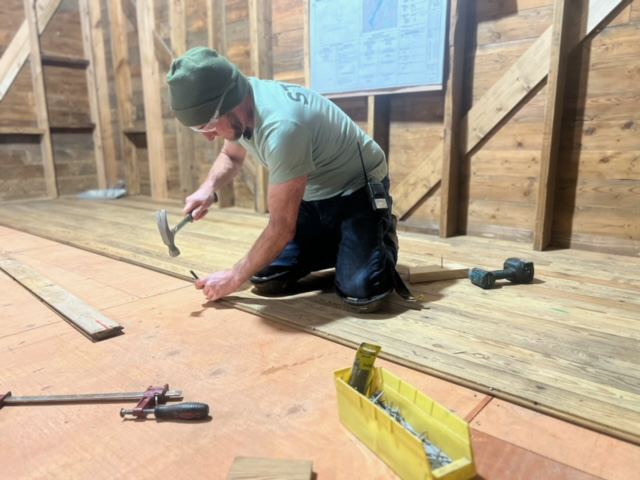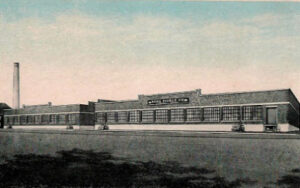
BY KRIS LEONHARDT
EDITOR-IN-CHIEF
ALLOUEZ/OCONTO – This summer, Heritage Hill State Historical Park will open their first new building in nearly a decade, which will serve as an educational tool highlighting the area’s migrant workers in the 20th century.
“The beauty of this structure is not necessarily that it’s big, it’s not necessarily that it’s got this crazy historical impact or power; but, one of the cool things that we haven’t had as great of an opportunity to do here at the park in many years is tell stories of other ethnicities that have come to the park. And with the unique labor history tied to the migrant cabin, it takes our story forward more into the 1940s-1950s,” Heritage Hill Director of Development Madeleine Buchholz-Kneeland said.
“So, it’s a unique way to be able to bring our story closer to the present. And then beyond that, Heritage Hill in the past has really focused the majority of its stories on European immigrants that came to this area.
“We have folks that have really diverse backgrounds. The Hispanic American population in Green Bay is the fastest-growing minority in the area.
And to be able to have folks be able to come here and see their stories represented here is really, really unique and really important to have that be represented here.”
“Green Bay was really a catalyst for labor history in the US, which I didn’t know literally until finding out about this migrant cabin that a lot of, you know, union and certainly workers rights — migrant workers rights — came to a head,” added Senior Marketing Specialist Elizabeth Jolly-Haslitt.
Labor migration
During the 20th century, laborers from the country’s southern states would come north during the slow southern growing season. While the migrant worker population began as single males, leaving their homes to obtain income to support or help support their families, after World War II families began migrating for work as a unit prompting the need for living quarters.
Recently, four UW-Green Bay interns — Kayla Erickson, Jacob Stuczynski, Jon O’Malley and Kim Krueger — studied the history of the migrant cabin with assistance from the UW-Green Bay Archives and Area Research Center.
Their research found that in the 1960s, there were over 300 migrant labor camps in Wisconsin.
“Many companies had more than one camp to house these migrant workers who were primarily engaged in the harvesting of cherries and cucumbers,” the group said in an article.
Bond Pickle Company
“Bond Pickle Company purchased cucumbers from local farms and manufactured them into pickles using the labor of migrant workers. Although mechanization was coming to agricultural fields, machinery was not able to be used for cucumber harvesting because cucumbers could be harvested multiple times per growing season. Because machines usually destroy a crop, preventing continued harvesting, local farmers relied on migrant labor for cucumber harvesting.
“To take advantage of as much migrant labor as possible, Bond Pickle Co. created ‘Bond Village,’ a group of cabins and facilities close to the farms so that migrant workers were able to have continued shelter and easy access to their worksites.

“These camps were not comfortable or safe locations to live in, with little access to simple amenities such as mattresses or fans for scorching summer weather. The cabins were as basic as the farmer or producer could make them because people would only live in the camps for a few months of the year.”
“I think an important thing too, is that the majority of the folks that were represented here are these migrants. They were American citizens. They were Hispanic Americans that are maybe third generation but they were traveling around the country. They would cycle through Texas, they would cycle through Minnesota through Nebraska. They would go all around the country and do this seasonal work, and live in structures like these. And when you go in there, and you realize holy bananas, they put 12 people in here more than that. And it’s like a 16 by 20-foot structure,” explained Madeleine Buchholz-Kneeland.
House No. 8
In 2017, Heritage Hill State Historical Park received the donation of a migrant home, which once served as living quarters for the Bond Pickle Factory in Oconto.
The home donated to Heritage Hill — house No. 8 — stood in Bond Village for four decades in a group of single-story, three-season wood structures” and served as home for migrant workers during the July to September cucumber harvesting season.
Most of the homes were removed from the village site in the early 1980s.
House No. 8 had been placed on a farm in southern Oconto County and used as a storage shed.
“One of the families that lived in this camp — in this cabin — basically said, ‘I want to save this and went to Heritage Hill and said, ‘You know, we think this is really important. Would you guys be able to acquire this building and be able to tell our story?” Madeleine Buchholz-Kneeland stated.
“It’s unique because the family actually stayed on here after. So, the gentleman was a migrant child that came with his family as a migrant worker. And then he ended up staying here and going on to kind of pursue higher education and really excel in the ‘American Dream,’” Jolly-Haslitt added.
His children also went on to build successful careers. The house was dissembled and transported to Heritage Hill in 18 pieces, including 12 wall sections, four roof sections and two floor sections, where it is being reassembled and prepared for an early May opening.
“So, it’s really a cool story, again, of what we think is the true American Dream. You come here and you live on something so small and you build your way into a real success story and give back to the community that raised you too,” Madeleine Buchholz-Kneeland said.
“That’s another great piece of this; they have this story, they were able to make something of themselves and come here and say, ‘This structure, save this please and be able to tell our story for future generations.’”
For more information, visit heritagehillgb.org.
